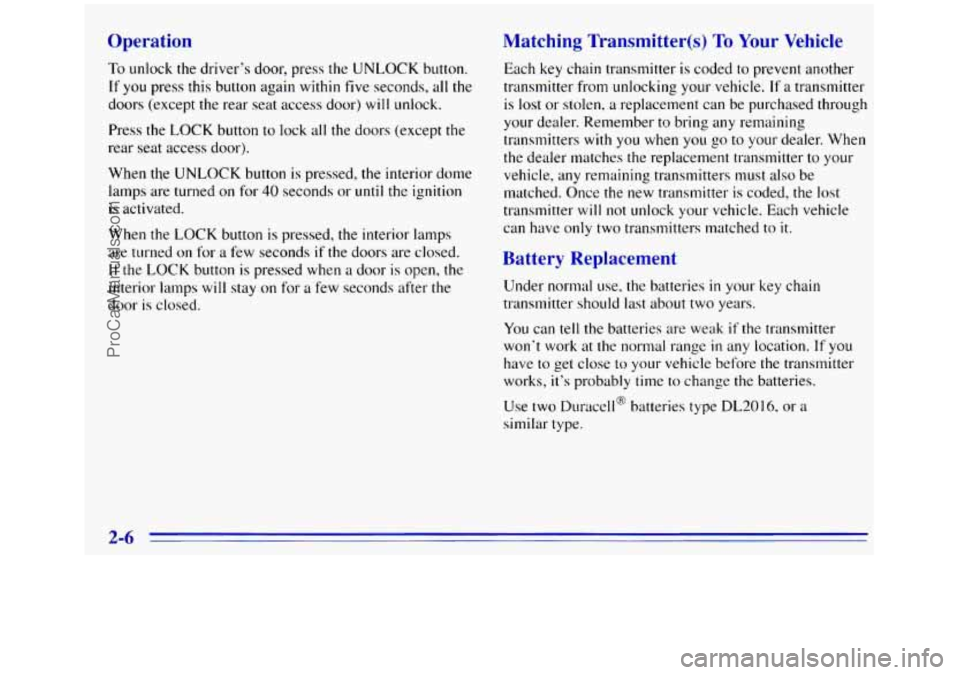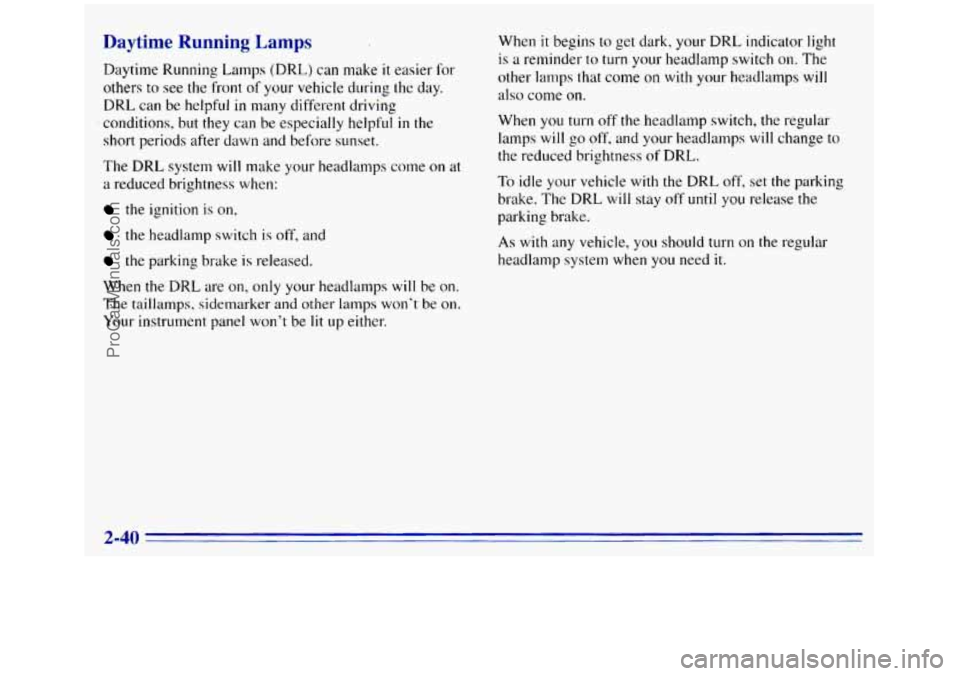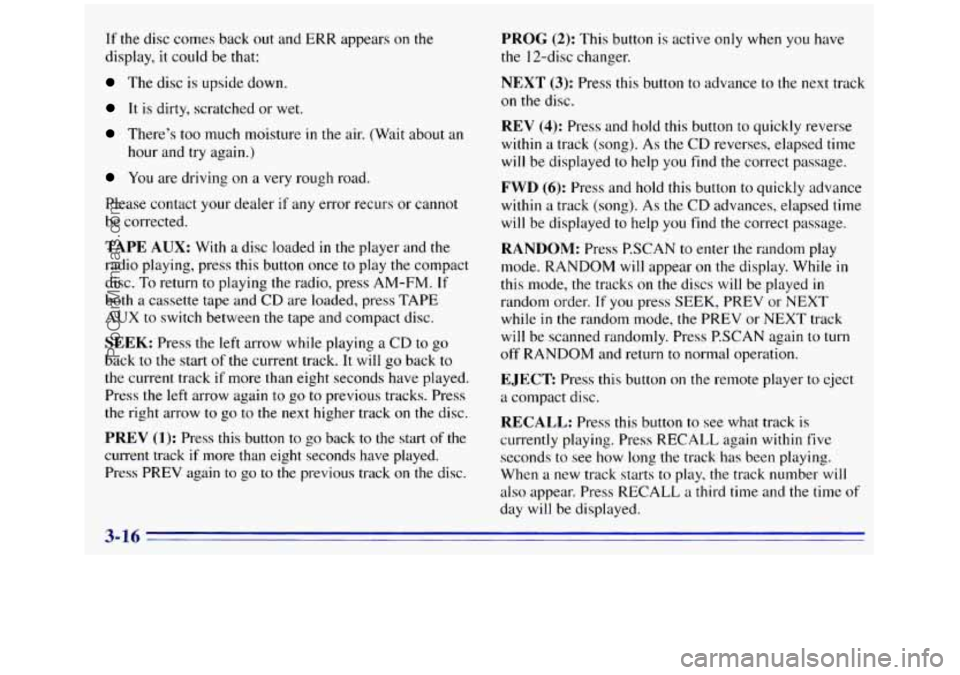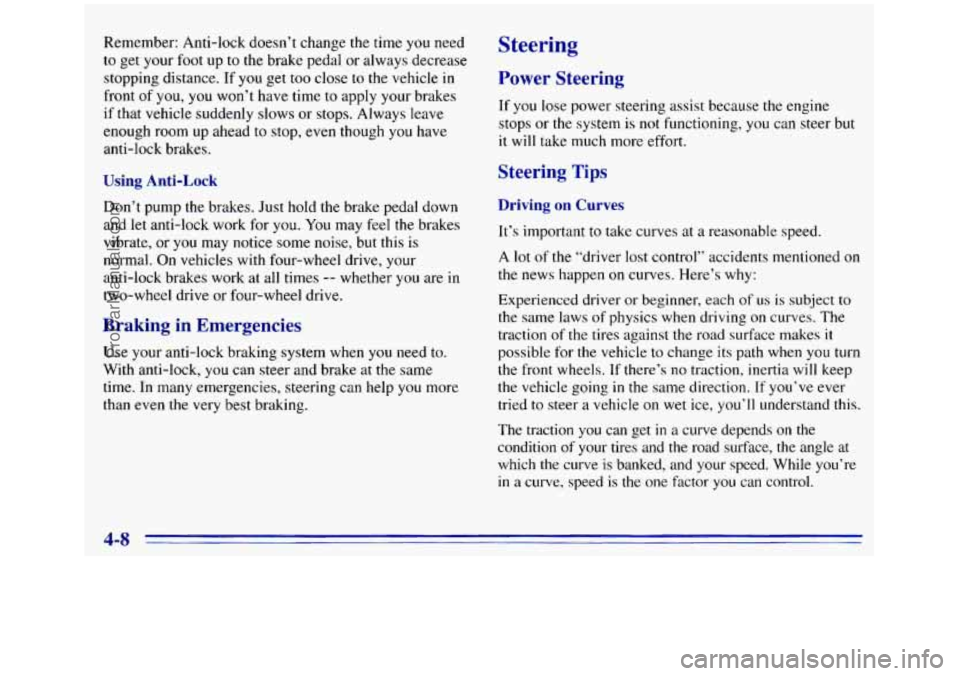1996 GMC SIERRA change time
[x] Cancel search: change timePage 4 of 404

GENERAL MOTORS, GM, the GM Emblem,
GMC TRUCK, the GMC TRUCK Emblem and
the name SIERRA are registered trademarks
of
General Motors Corporation.
This manual includes the latest information at
the time it
was printed. We reserve the right to make changes in the
product after that time without further notice. For
vehicles first sold in Canada, substitute the name
“General Motors of Canada Limited” for GMC Truck
Division whenever it appears in this manual.
Please keep this manual
in your vehicle, so it will be
there if you ever need
it when you’re on the road. If you
sell the vehicle, please leave this manual in it so the new
owner can use
it.
Litho in U.S.A.
X9604 B First Edition
‘--) We support voluntary
technician certification.
WE SUPPORT VOLUNTARY TECHNICIAN
CERTIFICATION THROUGH
National Institute for
AUTOMOTIVE SERVICE EXCELLENCE
For Canadian Owners Who Prefer a
French Language Manual:
Aux propriCtaires canadiens: Vous pouvez vous
procurer un exemplaire de ce guide en franGais chez
votre concessionaire
ou au:
DGN Marketing Services Ltd.
1500 Bonhill Rd.
Mississauga, Ontario L5T IC7
‘Copyright General Motors Corporation 1995
All Rights Reserved
ii
ProCarManuals.com
Page 68 of 404

Operation
To unlock the driver’s door, press the UNLOCK button.
If you press this button again within five seconds, all the
doors (except the rear seat access door)
will unlock.
Press the
LOCK button to lock all the doors (except the
rear seat access door).
When the UNLOCK button is pressed, the interior dome
lamps are turned on for
40 seconds or until the ignition
is activated.
When the LOCK button is pressed, the interior lamps
are turned on for
a few seconds if the doors are closed.
If the LOCK but.ton is pressed when a door is open, the
interior lamps
will stay on for a few seconds after the
door
is closed.
Matching Transmitter(s) To Your Vehicle
Each key chain transmitter is coded to prevent another
transmitter from unlocking your vehicle.
If a transmitter
is lost or stolen, a replacement can be purchased through
your dealer. Remember to bring any remaining
transmitters
with you when you go to your dealer. When
the dealer matches
the replacement transmitter to your
vehicle, any remaining transmitters must also be
matched. Once the new transmitter
is coded, the lost
transmitter will
not unlock your vehicle. Each vehicle
can have only two transmitters matched to
it.
Battery Replacement
Under normal use. the batteries in your key chain
transmitter should last
about two years.
You can tell the batteries are weak
if the transmitter
won’t work at the normal range
in any location. If you
have to get close to your vehicle before the transmitter
works,
it’s probably time to change the batteries.
Use two Duraeell@ batteries type
DL2014, or a
similar type.
2-6
ProCarManuals.com
Page 102 of 404

Daytime Running Lamps
Daytime Running Lamps (DRL) can make it easier for
others to see the front of your vehicle during the day.
DRL can be helpful in many different driving
conditions, but they can be especially helpful
in the
short periods after dawn and before sunset.
The
DRL system will make your headlamps come on at
a reduced brightness when:
the ignition is on,
the headlamp switch is off, and
the parking brake is released.
When the
DRL are on, only your headlamps will be on.
The taillamps, sidemarker and other lamps won’t be on.
Your instrument panel won’t be lit up either. When
it begins to get dark, your DRL indicator light
is a
reminder to turn your headlamp switch on. The
other lamps that
come on with your headlamps will
also come on.
When you turn off the headlamp switch, the regular
lamps will go off, and your headlamps
will change to
the reduced brightness of DRL.
To idle your vehicle with the DRL off, set the parking
brake.
The DRL will stay off until you release the
parking brake.
As with any vehicle, you should turn on the regular
headlamp system when
you need it.
2-40
ProCarManuals.com
Page 142 of 404

SCAN: Press and hold SEEK for two seconds until
SCAN appears on the display. SCAN allows you to
listen to stations for
a few seconds. The receiver will
continue to scan and momentarily stop at each station
until you press the button again. The sound will mute
while scanning.
AUTO TONE: Press this button to select among the
five preset equalization settings and tailor the sound to
the music or voice being heard. Each time
you press the
button, the selection
will switch to one of the preset
settings of CLASSIC, NEWS, ROCK, POP or JAZZ.
To
return to the manual mode, press and release this button
until MAN appears on the display. This will return the
tone adjustment to the TREB and BASS controls. If a
TREB or BASS control
is rotated, the AUTO TONE
setting will change to MAN.
PUSHBUTTONS: The six numbered pushbuttons let
you return to your favorite stations. You can set up to
18 stations (six AM, six FM 1 and six FMZ).
1. Press AM-FM to select the band.
2. Tune in the desired station by pressing TUNE or the
SEEK left or right arrows.
3. Press AUTO TONE to select the setting you prefer.
4. Press and hold one of the six pushbuttons.
5. The sound will mute. When it returns, release the
button. Whenever you press that numbered button, the
station you set will return and the
tone you selected
will be automatically selected for that button.
PSCAN: The preset scan button lets you scan through
your hvorite stations stored on your pushbuttons. Select
either the AM,
FMI or FM2 mode and then press
P.SCAN. It will scan through each station stored on your
pushbuttons and stop for a few seconds before
continuing to scan through all
of the pushbuttons. Press
P.SCAN again
or one of the pushbuttons to stop
scanning to listen
to a specific preset station. P.SCAN
will light up
on the display while in this mode. If one of
the stations stored on a pushbutton
is too weak for the
location you are in, the radio display will show the
channel number
(P 1 -P6) for several seconds before
advancing
to the next preset station.
3-12
ProCarManuals.com
Page 143 of 404

Setting the Tone Playing a
Cassette Tape
BASS: Press lightly on this knob to release it from its
stored position. Turn the knob clockwise
to increase the
bass and counterclockwise to decrease the bass. When
the BASS control is rotated, the AUTO TONE setting
will change to
MAN. Push the knob back in to its stored
position when done.
TREB: Press lightly on the TREB knob to release it
from its stored position. Turn the knob clockwise to
increase the treble and counterclockwise to decrease
the treble. When the
TREB control is rotated, the
AUTO TONE setting will change to MAN. Push the
knob back
in to its stored position when done.
Adjusting the Speakers
BAL: Press this button to remove the control from its
stored position. Turn the control clockwise to adjust
sound to the right speakers and counterclockwise to
adjust sound
to the left speakers. Press the button again
to return BAL to its stored position.
FADE: Press this button to remove the control from its
stored position. Turn the control clockwise to adjust the
sound to the front and counterclockwise for rear
speakers. Press the button again to return
FADE to its
stored position.
Your tape player is built to work best with tapes that are
30 to 45 minutes long on each side. Tapes longer than
that are
so thin they may not work well in this player.
To load a cassette tape with the ignition off. press
EJECT or RECALL. Then, insert the cassette tape.
If the ignition is on but the radio is off, the tape will
begin playing.
The player automatically senses
if the cassette tape
is metal or CI-02 and adjusts for best playback sound.
For metal tapes, the double-D symbol will appear on
the display.
Once
the tape is playing. use the VOL, BAL, FADE,
TREB and BASS controls just as you do for the radio.
The tape symbol and
a direction arrow will be on the
display whenever
a tape is being played. Anytime a tape
is inserted. the top side is selected for play first.
PREV (1): Press the PREV or the SEEK left arrow to
search for the previous selection. A minitnurn
three-second blank pap
is required for the player to stop
at the beginning of the selection. The tape direction
arrow will blink during the
SEEK operation.
PROG (2): Press this button to switch frotn one side of
the tape to the other.
3-13
ProCarManuals.com
Page 146 of 404

If the disc comes back out and ERR appears on the
display, it could be that:
The disc is upside down.
It is dirty, scratched or wet.
There’s too much moisture in the air. (Wait about an
hour and try again.)
You are driving on a very rough road.
Please contact your dealer
if any error recurs or cannot
be corrected.
TAPE AUX: With a disc loaded in the player and the
radio playing, press this button once to play the compact
disc.
To return to playing the radio, press AM-FM. If
both a cassette tape and CD are loaded, press TAPE
AUX to switch between the tape and compact disc.
SEEK: Press the left arrow while playing a CD to go
back to the start of the current track. It will go back to
the current track if more than eight seconds have played.
Press
the left arrow again to go to previous tracks. Press
the right arrow
to go to the next higher track on the disc.
PREV (1): Press this button to go back to the start of the
current track if more than eight seconds have played.
Press PREV again to
go to the previous track on the disc.
PROG (2): This button is active only when you have
the 12-disc changer.
NEXT (3): Press this button to advance to the next track
on the disc.
REV (4): Press and hold this button to quickly reverse
within a track (song). As the CD reverses, elapsed time
will be displayed
to help you find the correct passage.
FWD (6): Press and hold this button to quickly advance
within a track (song). As the CD advances, elapsed time
will be displayed to help you find the correct passage.
RANDOM: Press P.SCAN to enter the random play
mode. RANDOM
will appear on the display. While in
this mode, the tracks on the discs will be played in
random order. If you press SEEK, PREV or NEXT
while
in the random mode, the PREV or NEXT track
will be scanned randomly. Press P.SCAN again
to turn
off RANDOM and return to normal operation.
EJECT: Press this button on the remote player to eject
a compact disc.
RECALL: Press this button to see what track is
currently playing. Press RECALL again within
five
seconds to see how long the track has been playing.
When
a new track starts to play, the track number will
also appear. Press RECALL
a third time and the time of
day will be displayed.
3-16
ProCarManuals.com
Page 149 of 404

BAS Press'lightly on this knob to release it from its
stored position. Turn the knob clockwise to increase the
bass and counterclockwise to decrease the bass. When
the
BASS control is rotated, the AUTO TONE setting
will change to
MAN. Push the knob back in to its stored
position when done.
TREB: Press lightly on the TREB knob to release it
from its stored position. Turn the knob clockwise to
increase the treble and counterclockwise
to decrease the
treble. When the TREB control is rotated, the AUTO
TONE setting will change to MAN. Push the knob back
in to its stored position when done.
Adjusting the Speakers
BAL: Press this button to remove the control from its
stored position. Turn the control clockwise
to adjust
sound
to the right speakers and counterclockwise to
adjust sound to the left speakers. Press the button again
to return BAL to its stored position.
FADE: Press this button to remove the control from its
stored position. Turn
the control clockwise to adjust the
sound to
the front and counterclockwise for rear
speakers.
Press the button again to return FADE to its
stored position.
Playing a Compact Disc
PWR: Press this knob to turn the system on. (Please
note that
you can also turn the system on when
you insert a compact disc into the player with the
ignition on.)
Insert
a disc partway into the slot, label side up. The
player will pull it
in. Wait a few seconds and the disc
should play. CD and
a CD symbol will also appear on
the display. Anytime you are playing a
CD, the letters
CD will be
next to the CD symbol.
If the disc comes back out and ERR appears on the
display,
it could be that:
You are driving on a very rough road. (The disc
should play when the road gets smoother.)
The disc is upside down.
0 It is dirty, scratched or wet.
0 It is very humid. (If so, wait about an hour and
try again.)
The disc player is very hot.
Press RECALL
to make ERR go off the display.
3-19
ProCarManuals.com
Page 162 of 404

Remember: Anti-lock doesn’t change the time you need
to get your foot up to the brake pedal or always decrease
stopping distance. If
you get too close to the vehicle in
front of you, you won’t have time to apply your brakes
if that vehicle suddenly slows or stops. Always leave
enough room up ahead to stop, even though you have
anti-lock brakes.
Using Anti-Lock
Don’t pump the brakes. Just hold the brake pedal down
and
let anti-lock work for you. You may feel the brakes
vibrate, or you may notice some noise, but this
is
normal. On vehicles with four-wheel drive, your
anti-lock brakes work at all times
-- whether you are in
two-wheel drive
or four-wheel drive.
Braking in Emergencies
Use your anti-lock braking system when you need to.
With anti-lock, you can steer and brake at the same
time. In many emergencies, steering can help
you more
than even the very best braking.
Steering
Power Steering
If you lose power steering assist because the engine
stops or the system is not functioning, you can steer but
it will take much more effort.
Steering Tips
Driving on Curves
It’s important to take curves at a reasonable speed.
A lot of the “driver lost control” accidents mentioned on
the news happen on curves. Here’s why:
Experienced driver or beginner, each
of us is subject to
the same laws
of physics when driving on curves. The
traction
of the tires against the road surface makes it
possible for the vehicle to change its path when you turn
the front wheels. If there’s no traction, inertia will keep
the vehicle going
in the same direction. If you’ve ever
tried to steer a vehicle on wet ice, you’ll understand
this.
The traction you can get in a curve depends on the
condition of your tires and
the road surface, the angle at
which
the curve is banked, and your speed. While you’re
in a curve, speed is the one factor you can control.
4-8
ProCarManuals.com